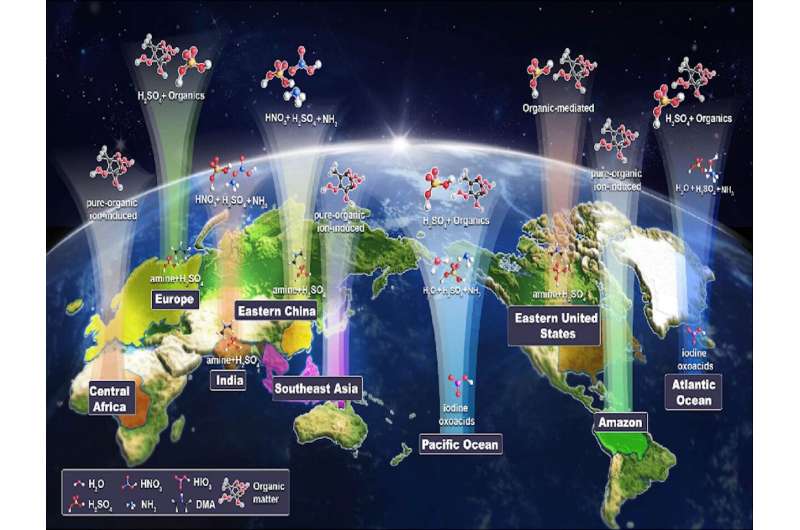This article has been reviewed according to Science X's editorial process and policies. Editors have highlighted the following attributes while ensuring the content's credibility:
fact-checked
peer-reviewed publication
trusted source
proofread
New model explains missing aerosol and cloud condensation nuclei

Atmospheric aerosol particles act as a key modulator of Earth's climate. New particle formation (NPF) from condensable gas molecules is the fundamental source of most atmospheric particles.
The subsequent growth of these particles is thought to contribute approximately half of the global number of cloud condensation nuclei (CCN), substantially affecting cloud properties and Earth's radiative balance.
Understanding the mechanisms of regional and global NPF is necessary for accurate estimation of aerosols' climatic effects and for attribution of such effects to controllable sources of primary particles and gases.
In a new study published in Nature, researchers synthesized molecular-level laboratory experiments to develop comprehensive model representations of NPF and the chemical transformation of precursor gases in the U.S. Department of Energy's Energy Exascale Earth System Model (E3SM).
Distinct dominant NPF mechanisms and their impacts on clouds around the world are quantified by combining model simulations and observations.
A new representation of the physicochemical processes underlying NPF is developed in E3SM to accurately simulate aerosols. Researchers show that particle formation in most aerosol-rich or cloud-susceptible regions is most probably dominated by "modern" NPF mechanisms discovered or quantified in the past decade.
The importance of these modern mechanisms on regional and global scales has been underappreciated because they were mostly missing or substantially biased in previous models.
The comprehensive representation of NPF mechanisms in this study will also facilitate detailed source apportionment of particles and CCN globally. This will further help with accurate attribution of aerosols' climatic effects to emission sources of precursor gases and primary particles, with implications for the development of targeted control policies.
Furthermore, clarification of NPF mechanisms has important implications for assessments of historical and future climate change, because particles arising from different mechanisms may undergo markedly different changes. This could have resulted in notably different aerosol loading changes in different regions, which would suggest different climatic effects of aerosols under future policy interventions.
In view of the regionally and vertically distinct NPF mechanisms (as well as their different past and future changes), it is imperative to adequately represent all of the main NPF mechanisms in climate simulations and projections, especially those considered in the assessment reports of the Intergovernmental Panel on Climate Change.
A key challenge in understanding the role of aerosols in the Earth system is understanding how atmospheric aerosol particles are formed. Although NPF mechanisms have been described at specific sites, in most regions such mechanisms remain uncertain to a large extent because of the limited ability of atmospheric models to simulate critical NPF processes.
Combined E3SM simulations and observations show that previously neglected or underrepresented mechanisms dominate NPF in most regions with high concentrations of aerosols or large aerosol radiative forcing.
Such regions include oceanic and human-polluted continental boundary layers, as well as the upper troposphere over rainforests and Asian monsoon regions. These underrepresented mechanisms also play notable roles in other areas, such as the upper troposphere of the Pacific and Atlantic oceans.
Accordingly, NPF accounts for 10%–80% of the nuclei on which clouds form at 0.5% supersaturation over various regions in the lower troposphere. The comprehensive simulation of global NPF mechanisms can help improve estimation and source attribution of the climate effects of aerosols.
More information: Bin Zhao et al, Global variability in atmospheric new particle formation mechanisms, Nature (2024). DOI: 10.1038/s41586-024-07547-1
Journal information: Nature
Provided by Pacific Northwest National Laboratory





















